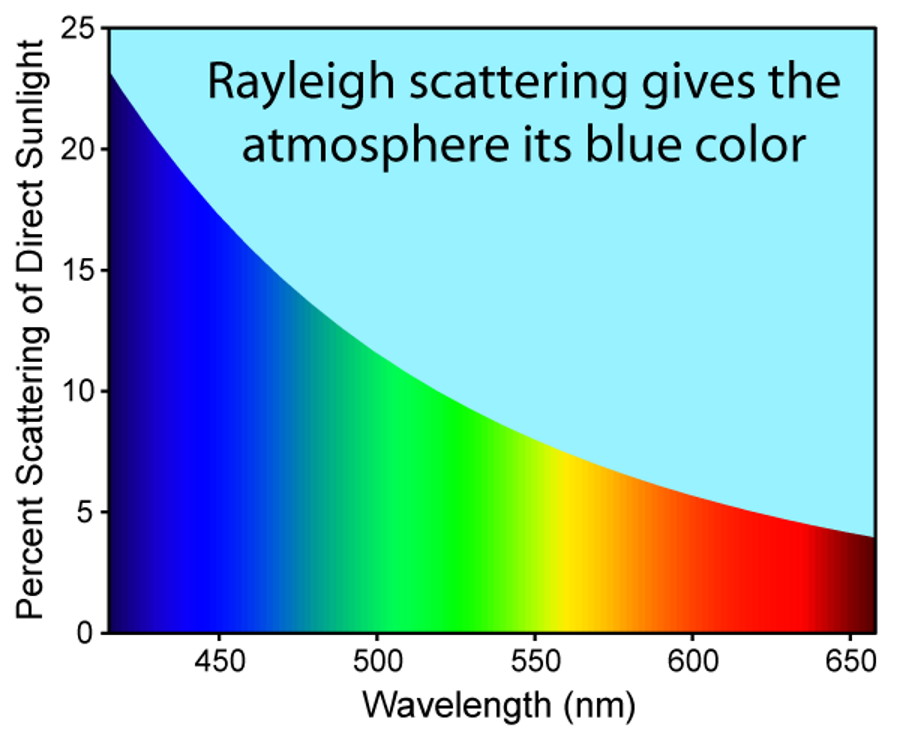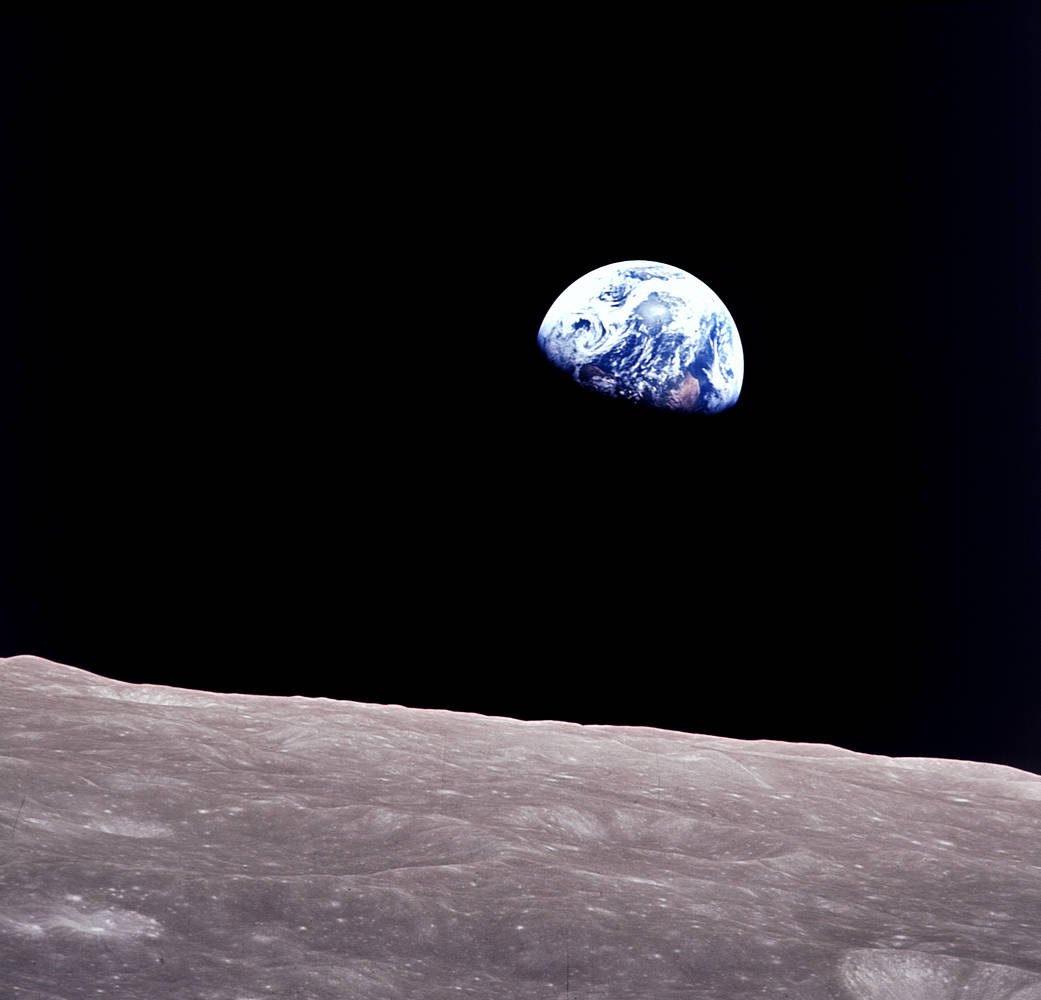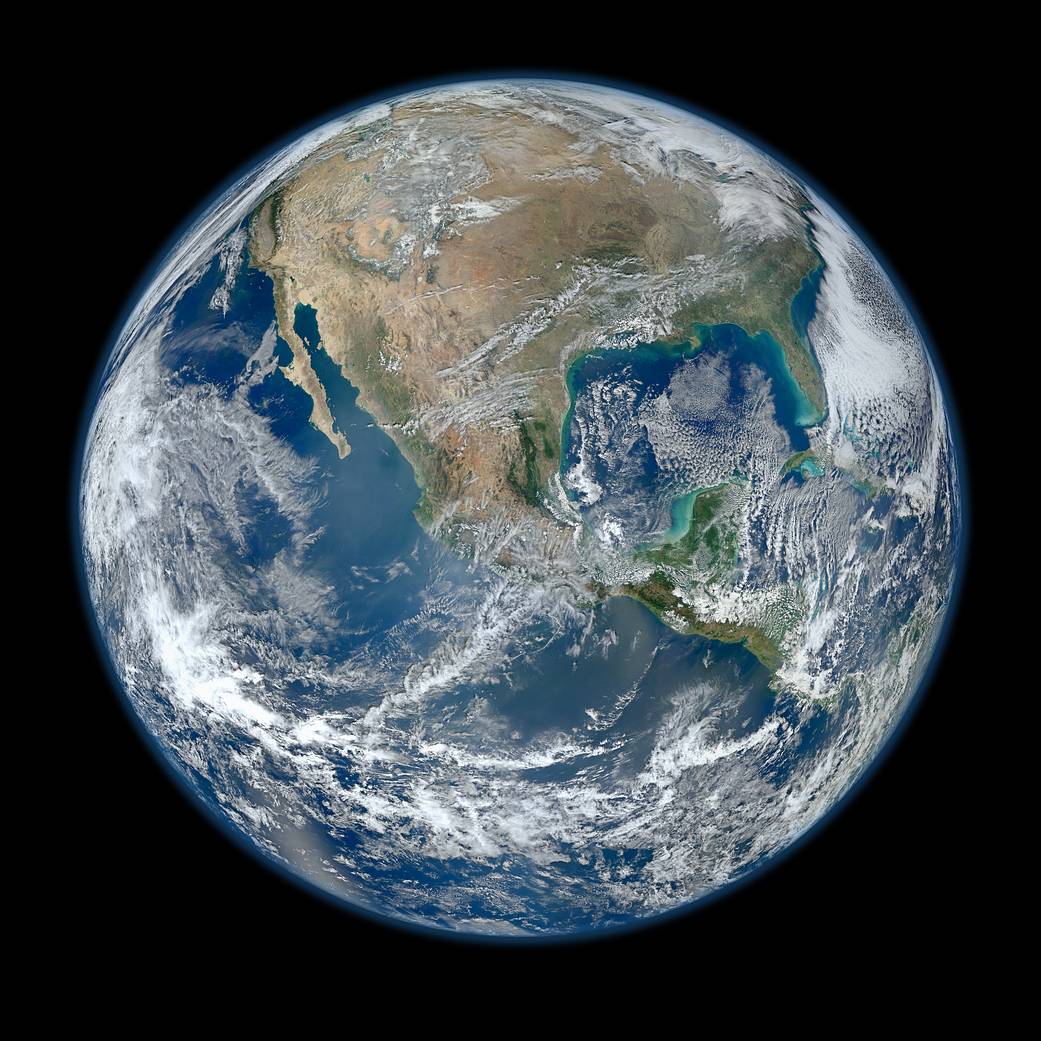Sun Rising Over the Ocean With Blue Sky
If you've ever been curious about the world you live in, you've probably wondered why the sky is blue. The incorrect answers that people often give in response include:
- that sunlight has a blue tint,
- that oxygen itself is a blue-colored gas,
- or that the sky reflects the oceans.
While none of those answers are correct, that last attempt brings up a related question that people often wonder about: why are the oceans blue?
As seen from space, planet Earth is often described as a pale blue dot, but it's only the liquid bodies of water — dominated by Earth's oceans — that appear blue-hued. The continents, clouds, and ice caps don't appear blue at all; it's the oceans, not the atmosphere, that give our planet its overall complexion. For thousands of years, humanity had to simply accept these properties of our world as facts. But with the advances of modern science, we understand why both the skies and oceans are blue.

When the Sun is high overhead, the sky towards the zenith is a much darker blue, while the sky towards the horizon is a lighter, brighter cyan color. This is due to the larger amount of atmosphere, and the larger amount of scattered light, that is visible at low angles on the sky.
Contrary to what you might have read, there's no one single factor responsible for Earth's blue skies.
The skies aren't blue because sunlight has a blue tint; our Sun emits light of many different wavelengths, and that light sums up to be a net white color.
Oxygen itself isn't a blue-colored gas, but rather is transparent to light.
However, there are a myriad of molecules and larger particles in our atmosphere that do play a role, scattering light of different wavelengths by different amounts. The ocean plays no role in the color of the skies, but the sensitivity of our eyes absolutely does: we do not see reality as it is, but rather as our senses perceive it and our brain interprets it.
These three factors — the Sun's light, the scattering effects of Earth's atmosphere, and the response of the human eye — are what combine to give the sky its blue appearance.

Schematic animation of a continuous beam of light being dispersed by a prism. If you had ultraviolet and infrared eyes, you'd be able to see that ultraviolet light bends even more than the violet/blue light, while the infrared light would remain less bent than the red light does.
When we pass sunlight through a prism, we can see how it splits up into its individual components. The highest energy light is also the shortest-wavelength (and high-frequency) light, while the lower energy light has longer-wavelengths (and low-frequencies) than its high-energy counterparts. The reason light splits up at all is because wavelength is the critical property that determines how light interacts with matter.
The large holes in your microwave allow short-wavelength visible light in-and-out, but keep longer-wavelength microwave light in, reflecting it. The thin coatings on your sunglasses reflect ultraviolet, violet, and blue light, but allow the longer-wavelength greens, yellows, oranges, and reds to pass through. And the tiny, invisible particles that make up our atmosphere — molecules like nitrogen, oxygen, water, carbon dioxide, as well as argon atoms — scatter light of all wavelengths, but preferentially are more efficient at scattering bluer, shorter-wavelength light.

Rayleigh scattering affects blue light more severely than red, but of the visible wavelengths, violet light is scattered the most. It's only due to the sensitivity of our eyes that the sky appears blue and not violet. The longest-wavelength and shortest-wavelength visible lights experience a difference in Rayleigh scattering by nearly a full order of magnitude.
There's a physical reason behind this: all the molecules making up our atmosphere are smaller in size than the various wavelengths of light that the human eye can see. The wavelengths that are closer to the sizes of the molecules present will scatter more efficiently; quantitatively, the law it obeys is known as Rayleigh scattering.
The violet light at the short-wavelength limit of what we can see scatters over nine times more frequently than the red, long-wavelength light at the other end of our vision. This is why, during sunrises, sunsets, and lunar eclipses, red light can still pass efficiently through the atmosphere, but the bluer wavelengths of light are practically non-existent, having been preferentially scattered away.

Some opalescent materials, like the one shown here, have similar Rayleigh scattering properties to the atmosphere. With white light illuminating this stone from the upper right, the stone itself scatters blue light, but allows the orange/red light to preferentially pass through undeterred.
Since the bluer wavelengths of light are easier to scatter, any incoming direct sunlight will become redder and redder the more atmosphere it passes through. The remainder of the sky, however, will be illuminated by indirect sunlight: light that strikes the atmosphere and then gets redirected towards your eyes. The overwhelming majority of that light will be blue in wavelength, which is why the sky is blue during the day.
Travel the Universe with astrophysicist Ethan Siegel. Subscribers will get the newsletter every Saturday. All aboard!
It will only take on a redder hue if there's enough atmosphere to scatter that blue light away before it reaches your eyes. If the Sun is below the horizon, all the light has to pass through large amounts of atmosphere. The bluer light gets scattered away, in all directions, while the redder light is far less likely to get scattered, meaning it takes a more direct path to your eyes. If you're ever up in an airplane after sunset or before sunrise, you can get a spectacular view of this effect.

From very high altitudes in the pre-sunrise or post-sunset skies, a spectrum of colors can be seen, caused by the scattering of sunlight, multiple times, by the atmosphere. Direct light, from close to the horizon, reddens tremendously, while far away from the Sun, indirect light only appears blue.
This might explain why sunsets, sunrises, and lunar eclipses are red, but might leave you wondering why the sky appears blue instead of violet. Indeed, there actually is a greater amount of violet light coming from the atmosphere than blue light, but there's also a mix of the other colors as well. Because your eyes have three types of cones (for detecting color) in them, along with the monochromatic rods, the signals from all four need to get interpreted by your brain when it comes to assigning a color.
Each type of cone, plus the rods, are sensitive to light of different wavelengths, but all of them get stimulated to some degree by the sky. Our eyes respond more strongly to blue, cyan, and green wavelengths of light than they do to violet. Even though there's more violet light, it isn't enough to overcome the strong blue signal our brains deliver, and that's why the sky appears blue to our eyes.

The first view with human eyes of the Earth rising over the limb of the Moon. The discovery of the Earth from space, with human eyes, remains one of the most iconic achievements in our species' history. Apollo 8, which occurred during December of 1968, was one of the essential precursor missions to a successful Moon landing, which will celebrate its 50th anniversary this July. Note the blue color of Earth is due to the oceans, not the atmosphere.
The oceans, on the other hand, are an entirely different story. If you take a look at the planet as a whole, with a view such as the one you get from space, you'll notice that the bodies of water we have aren't a uniform blue, but rather vary in their shade based on the water's depth. Deeper waters are a darker blue; shallower waters are a lighter blue.
You'll notice, if you look closely at a photo like the one below, that the watery regions bordering the continents (along the continental shelves) is a lighter, more cyan shade of blue than the deep, dark depths of the ocean.

The Earth's oceans may appear blue, but along the continental shelves, they appear a lighter shade of blue than in the deepest parts of the ocean. This is not an artifact of the way the image was constructed, but a real phenomenon that details the difference between what's absorbed and reflected by the ocean itself at various depths.
If you want a more direct set of evidence that the oceans themselves appear blue, you could try diving down beneath the water's surface and recording what you see. When we do this, taking a photograph underwater in natural light — i.e., without any artificial light sources — we can immediately see that everything takes on a bluish hue.
The farther down we go, as we reach depths of 30 meters, 100 meters, 200 meters and more, the bluer everything appears. This makes a lot of sense when you remember that water, just like the atmosphere, is also made out of molecules of a finite size: smaller than the wavelengths of any light that we can see. But here, in the depths of the ocean, the physics of scattering is a little different.

If you descend down into a body of water and only allow your surroundings to be illuminated by natural sunlight from above, you'll find that everything takes on a bluish tint, as red light is the first to have its wavelengths absorbed away entirely.
Instead of scattering, which is the primary role of the atmosphere when light passes through it, a liquid like water primarily absorbs (or doesn't absorb) light. Water, like all molecules, has a preference for the wavelengths it can absorb. Rather than having a straightforward wavelength dependence, water can most easily absorb infrared light, ultraviolet light, and red visible light.
This means if you head down to even a modest depth, you won't experience much warming from the Sun, you'll be protected from UV radiation, and things will start to turn blue, as the red light is taken away. Head down a little deeper, and the oranges go away, too.

At deeper depths, when the sea is illuminated by natural sunlight from above, not only red colors but oranges and yellows begin to disappear. Even lower down, greens will be absorbed, too, leaving only faint blue light to be observed.
Past that, the yellows, greens and violets start to get taken away. As we head down to depths of multiple kilometers, finally the blue light disappears as well, although it's the last to do so.
This is why the deepest ocean depths appear a deep, dark blue: because all the other wavelengths get absorbed. The deepest blues, unique among all the wavelengths of light in water, have the highest probability of getting reflected and re-emitted back out. As it stands, the global average albedo (the technical term for reflectivity) of our planet is 0.30, meaning 30% of the incident light gets reflected back into space. But if the Earth were entirely deep-water ocean, our albedo would be just 0.11. The ocean is actually pretty good at absorbing sunlight!

Two-hemisphere global composites of Moderate Resolution Imaging Spectroradiometer (MODIS) data, taken in 2001 and 2002. Note that it's our oceans, and not the skies but our oceans alone, that give our planet its blue appearance from space.
The sky and ocean aren't blue because of reflections at all; they're both blue, but each of their own volition. If you took our oceans away entirely, a human on the surface would still see blue skies, and if you managed to take our skies away (but still somehow gave us liquid water on the surface), our planet would still appear blue from faraway in space.
For the skies, the blue sunlight scatters more easily, and comes to us indirectly from where sunlight strikes the atmosphere as a result. For the oceans, longer-wavelength visible light gets absorbed more easily, so the deeper they go, the darker bluer the remaining light appears. Blue atmospheres may be common for planets, as Uranus and Neptune both possess them, too, but we're the only one we know of with a blue surface. Perhaps when we find another world with liquid water on its surface, we'll discover that we aren't so unique after all, and in more ways than we even presently realize!
Source: https://bigthink.com/starts-with-a-bang/why-sky-ocean-blue/
0 Response to "Sun Rising Over the Ocean With Blue Sky"
Post a Comment